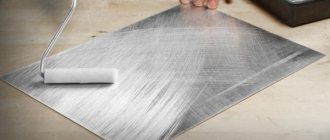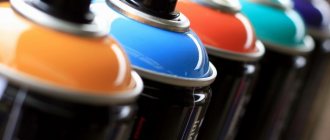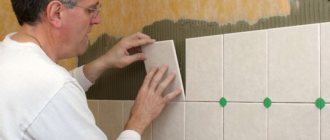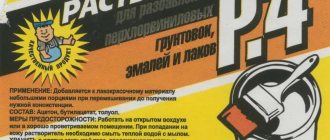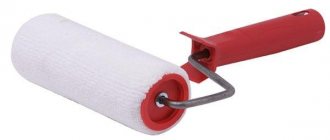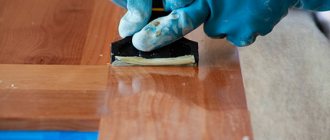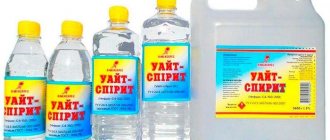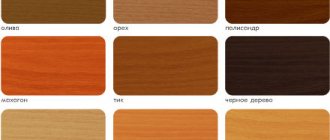Acrylic varnishes are very popular today, as they are inexpensive, dry quickly, are easy to apply, and look very attractive. The varnished layer is very strong and durable and can only be removed with a special solvent. Acrylic varnishes are usually sold ready-to-use, but there are situations when they become very thick or are sold in the form of a paste, which requires a special thinner. In this case, the question arises, what and how to dilute acrylic varnish? This article will look at how different types of these compounds are diluted, and how to work correctly with varnish solutions.
Acrylic varnish is a high-quality mixture of acrylic resin, driers and solvents; this composition is used to protect and decorate wooden, concrete, brick, and other surfaces. After drying, a very strong and elastic film is formed, which provides protection from adverse factors and mechanical stress.
This material has excellent technical and physical characteristics:
- withstands temperature changes well;
- is resistant to ultraviolet rays;
- at joints it has a good strength indicator;
- has good mechanical stability.
How to properly dilute wood varnish?
At first glance, there is no difference.
Using a special tool, we bring the varnish substance into “working condition”. A solvent is a liquid that dissolves dried varnish, bringing it from a solid to a liquid state. We use a thinner if we need to change (reduce) the viscosity of paints. Some types of organic eluents perform both roles, but some may be effective in one task and completely useless in another. For example, white spirit can be used to dilute compositions of polyurethane, alkyd and oil groups. But if the varnish has dried, it will not be possible to dissolve it with white spirit.
White spirit can be used to thin some varnishes.
But shellacs, on the contrary, are equally dissolved and diluted with denatured alcohols. But let's not go into such subtle details.
If you need advice on what to thin varnish or what to use for thinning paints, it is better to consult with specialists in this field.
We propose to consider in detail which solvents need to be used in specific cases.
What is the difference between solvents and thinners
There is a big difference between these two products: the solvent affects the hardness of the varnish solution, and the thinner affects its viscosity. It is important to know what exactly can be used to dilute the varnish mixture - an organic solvent or water.
Water-based varnish materials are diluted with glycol ether or plain water. And these compounds are dissolved using xylene or a combined solvent composition. Those varnishes that are based on an organic solvent can be diluted with the solvent material that is already contained in the composition.
Dilution, dilution or dilution?
It may seem that these concepts are identical to each other. But this is a misconception. How to dilute the varnish if it has thickened, and what else can be done in this case, because this situation happens quite often? Use special tools belonging to one of two categories:
- A solvent is a liquid that is named for the effect it has on the substrate. This substance simply transfers the thickened varnish from a solid state to a liquid state.
Thinner - this product is used when it is necessary to change the viscosity of paints. There are varieties of substances that can act in several roles at once, including being used for breeding.
Some products are effective at performing only one function. For example, white spirit is suitable for diluting the following compositions:
- oil;
- alkyd;
- belonging to the polyurethane group.
When the varnish has completely hardened, white spirit cannot be a solution to the question of what can be used to dilute the varnish. Therefore, we have to look for other options. So-called denatured alcohols equally help to dissolve the varnish and simply obtain a diluted composition.
On video: differences between thinners and solvents for varnishes.
Varnish production
The production process of this paint and varnish material is quite complex. It is based on the following steps:
- dissolving resins and colloxylin in organic solvents,
- connection with plasticizers and other additives,
- measuring the indicators of the received material,
- cleaning, filtration,
- spilling into containers.
To obtain black varnish and its other shades, the necessary pigments are added at a certain stage of production. In their absence, the result is a colorless varnish. Each component is administered in a regulated quantity, and the rate of the rest changes based on the volume of colloxylin.
Attention! The preparation of colloxylin is carried out under special conditions due to its explosiveness and flammability. This substance is stored only in sealed containers under special conditions.
When producing a material, you can change its density - if it is too liquid, add colloxylin, if it is thick, add solvents. Homogeneity is achieved by introducing high-quality and purified components, as well as subsequent purification in centrifuges.
Wood varnishing:
We are talking about the situation when you have already completely processed your wooden product (sanded, treated with insect repellent, or covered with stain), and all you have to do is coat it with varnish. Varnishing wood is a very simple procedure if you know a few features. For example, you need to consider the grain of the type of wood your piece is made from. For each type of wood there is probably a suitable type of varnish. This is very important to take into account because wood coated with varnish can acquire a new shade (darker or lighter) and even new properties (fire resistance). And the most annoying thing is if, after a painstaking and long selection of colors (for example, when carving wood), you varnish and the colors fade. Try to coat the wood product with an adequate type of wood varnish.
Technical characteristics of varnishes
Depending on the specific brand, the technical characteristics of the products may vary. Varnishing is carried out after studying the recommendations and assessing the parameters of a particular product.
Among the most widely used brands there are three main ones; let’s look at them in more detail.
NTs-62
The NTs-62 material is used for decorative finishing of products, as the product gives them an attractive appearance. Can serve as paint as it comes in red, purple, green and other colors. In addition to wood, this product can be used to cover mosaic display cases, illumination lamps, glass, metal, and paper products.
Characteristics:
- viscosity according to the viscometer VZ-246 – 26–40 s,
- volume of dry residue – 7–12%,
- coating quality – colorless, colored, transparent, glossy,
- consumption – 70–100 g/sq.m. m.
For dilution, solvent No. 646 is used. The varnish is applied in 1–2 layers, and each layer must be completely dry to touch.
NTs-218
This varnish is used mainly for coating furniture and wooden window sills. It dries very quickly - no more than an hour at room temperature. It is important that the surface is smooth and dry before application. If all recommendations are followed, the coating will last about 10 years.
A distinctive feature of the product is the special antiseptic components added to it, which will prevent the wood from rotting and insects from appearing in it. Coating the inside of your cabinets with it will help keep things from getting snagged. Varnish allows you to matt the surface of the product, giving it a noble appearance.
Characteristics of NTs-218:
- viscosity according to the viscometer VZ-246 – 50–85 s,
- dry residue share – 30–34%,
- film elasticity for bending – 15 mm,
- TML – 0.2 cu. e.,
- color – colorless.
NTs-243
The NTs-243 product can be used to process any wooden objects. It creates a film of a yellowish or pinkish tint, dries quickly, mattifies, and hides various defects. Drying time for the coating is an hour.
Main parameters:
- light fastness – 1 hour,
- coating strength according to the M-3 device - 0.4 cu. e.,
- dry residue share – 26–32%,
- TML – 0.2 cu. e.,
- the coating is smooth, without foreign inclusions, pockmarks, wrinkles, craters.
How to dilute varnish on wood
Varnishing surfaces, products and materials is an excellent way to decorate and protect from moisture, temperature and damage. Varnishes are used for household and industrial purposes. The compositions can be used to coat wooden, metal, plaster, brick, and concrete surfaces - a specific varnish is suitable for each material. To ensure that the composition acquires the viscosity required for work, varnish thinner is used. The product differs from the solvent in its characteristics and purpose.
Groups of thinners and solvents
When using chemicals and paints and varnishes, it becomes necessary to prepare a working composition of the required consistency. A varnish thinner is a product that reduces the viscosity and density of a composition. The solvent is used to soften the structure of the dried substance, that is, in cases where it is necessary to remove the coating or clean work equipment.
All solvents and thinners are classified into five main groups:
- Petroleum and aromatic hydrocarbons. Popular distillates are white spirit, kerosene, paraffin, xylene, toluene, and petroleum jelly. Used to dilute oil and polyurethane products.
- Glycol ethers. Can be used as a binding component for water-based stains and paints. Glycol ethers are used to dilute and dissolve nitro varnishes.
- Ketones. Widely used as industrial solvents and paint thinners. A common diluent in the ketone group is acetone, used to dilute polyurethane substances and nitro varnishes.
- Alcohols. Diluents are included as independent components or in combination with esters or ketones. Suitable for alcohol-based compositions, shellac, nitro varnish.
- Ethers. Ethers are used to dilute film formers based on glyphthalic resins. Esters are used to dissolve any compositions with nitrocellulose.
The terms solvent and diluent are often used interchangeably. The difference between them is that some can be diluted with solid, while others can be diluted with liquid film formers. But some products are universal - they both dilute and dissolve compounds.
On video: what is the difference between solvents and thinners.
Types of varnishes for wood processing
The most widely used compositions are for varnishing wooden surfaces. Wood varnish prevents the material from rotting when exposed to moisture, protects against mold and mildew and preserves the beautiful wood texture; it can highlight and change the color of the wooden surface. In order for wood varnish to adhere well to the workpiece (panel, furniture, souvenir, floor covering), the working fluid must be given the required viscosity.
The thinner is selected depending on the composition of the film former. There are several types of funds:
- Alkyd. Components: pentaphthalic, glyphthalic, alkyd, melamine-formaldehyde resin in combination with organic solvents and driers. Alkyd varnishes are characterized by good adhesion, moisture resistance, and neutrality to ultraviolet radiation.
- Polyurethane. The main component is a polyurethane polymer combined with special chemicals. They are highly resistant to abrasion, protect wood well from moisture, and form a durable elastic film.
- Bitumen. The composition includes bitumen in combination with resins and oils. Once dissolved and applied to a wooden surface, it leaves a layer of black film. They are used to decorate products using patination technology with the effect of artificial aging.
- Yachting. Yacht paintwork materials show high resistance to contact with moisture and are characterized by a long service life and durability. Yacht varnish is resistant to temperature and aggressive environments. Yacht varnish is used for interior and exterior work.
- Oily. They contain solutions of natural or synthetic resins, modified with vegetable oils with the addition of solvents and driers. After application, they form a durable yellowish film.
- Nitrocellulose. Nitrocellulose substances are based on cellulose nitrate dissolved in organic solvents. Nitrovarnishes dry quickly, protect treated wood well from moisture, and form a uniform varnish film on the surface.
- Petroleum polymers. Resistant to chemicals and detergents. It is obtained by combining petroleum polymer resins with solvents and modifying additives. Wood compositions show high abrasion resistance.
Selecting a thinner
To choose the right varnish thinner, you need to know the component composition of the substance or the group to which the paint and varnish material belongs. A specific thinner is suitable for each varnish. It is necessary to choose a means to dilute rather than dissolve the substance.
Wood and wood products are widely used in construction, the manufacture of furniture, wall panels, flooring and other interior items, and are also used for the manufacture of windows, doors, and stairs. The quality of wood coating determines its service life. Varnishing is the most effective way to decorate and protect wood material. To apply the coating, the working composition must be moderately liquid.
How to dilute varnish from various components:
- To reduce the viscosity of alkyd varnish, white spirit is used. Yacht varnish is also diluted with white spirit.
- To dilute polyurethane substances, toluene, xylene, acetone, and solvents R-4 and R-5 are used.
- Nitrovarnish can be dissolved to the desired consistency using a combined mixture of toluene and xylene.
- Oil and polyurethane varnishes are diluted with turpentine, white spirit and solvent.
- Alcohol-based thinners are suitable for diluting nitro varnishes and shellacs.
- Glycol ether dilutes water-based compositions and nitrocellulose varnishes.
- A hardener is first added to epoxy compositions and then diluted with a mixture of xylene, acetone and ethylcellulose.
- Water-based products are diluted with water in an amount of no more than 10 percent of the varnish volume.
- Acetone can be used to dilute mixtures based on epoxy and natural resins, and for yacht paints and varnishes, white spirit is used in an amount of 5%!
The introduction of a diluent reduces the viscosity of the liquid. To remove any remaining dried product, solvents are applied to the treated surface. They are used to clean tools and equipment used in varnishing.
After softening, the varnish film is removed with a thin spatula. If the layer is very durable, it can be removed from the wooden surface by scraping and processing with coarse and fine-grained abrasives and sandpaper.
Main types of solvents
All compositions that are used for diluting and diluting varnishes differ in properties. When working with them, you must adhere to basic precautions - use personal protective equipment, beware of getting the solvent in your eyes, nose and mouth, and ventilate the room. Almost all compositions are fire hazardous and require proper storage and careful use.
The most common thinners:
- White spirit - has an average evaporation rate, is practically odorless, dilutes yacht and other varnishes.
- Solvent - evaporates quickly, highly flammable, flammable.
- Ethyl alcohol is a colorless solvent liquid with a specific odor that spontaneously ignites at 402 degrees.
- Petroleum benzene is insoluble in aqueous solution and interacts with gasoline, kerosene and turpentine.
- Turpentine - dries slowly, smells unpleasant, can spontaneously ignite, suitable for diluting oil varnishes.
- Solvents for nitro varnishes – improve the quality of the film-forming agent and ensure good adhesion of the coating.
- Methanol is a dangerous, toxic solvent; it dilutes shellac and alcohol-based compositions well.
- Butyl alcohol - dilutes nitrocellulose paints and varnishes, gives the varnish shine and mechanical strength.
- Ethylene glycol is a viscous, odorless substance that is used to dilute the composition.
- Methyl acetate - evaporates and dries quickly, the substance is highly toxic.
- Butyl acetate is a yellowish substance that takes a long time to evaporate from the surface, increasing the drying time of the varnish.
- Ethyl acetate is a pleasant-smelling substance with a high evaporation rate.
- Acetone - dissolves and dilutes most varnishes, has an unpleasant, pronounced odor.
Popular brands of solvents are 646 and 647. Solvent 646 is a mixture of several components that, when combined, dilute epoxy and acrylic varnishes well. The 647th solvent consists of toluene, butanol, ethyl acetate and butyl acetate. Used to dilute nitro varnishes.
Solvent P-4 contains a compound of esters, ketones and aromatic carbons. Suitable for thinning varnishes based on vinyl acetate and its copolymers.
Using a varnish thinner allows you to obtain the working composition of the required consistency and give the coating additional strength. The applied layer becomes uniform, the composition is easy to work with using rollers or paint brushes.
Yacht varnish can be matte or glossy. The matte finish does not add shine to wooden products and hides dust and dirt well. A floor covered with a matte composition is more practical , as it does not require careful maintenance.
The glossy coating gives the floor a special shine and looks very elegant, but requires constant specialized care.
The composition of yacht varnishes can be:
- alkyd;
- alkyd-urethane;
- urethane-alkyd;
- acrylate.
Alkyd compositions are the most popular . This is explained by the adequate price-quality ratio of the coating, high wear resistance and the ability to penetrate deeply into the pores of wood. Among the disadvantages of alkyd varnishes: the release of toxic fumes while the coating dries. The evaporation continues even after the substance has completely dried, although it is no longer as strong. They can cause allergies in the residents of the house .
The alkyd-urethane composition has a fast drying time (no more than 6 hours). When working with these solutions, you must use gloves and a respirator.
Urethane-alkyd compositions are less toxic than previous ones. This is explained by the presence of urethane plasticizers in the composition, which prevent harmful substances from evaporating and increase the resistance of the varnish film to temperature fluctuations. Urethane-alkyd varnishes can be used in any room, including heated floors.
The basis of acrylate compositions is water, due to which the toxicity of these varnishes is minimized. This coating is not highly durable or waterproof, but it can even be used in a child’s room.
How to apply nitro varnish to a surface
If you need to coat small parts with nitro varnish, for example, wooden handles, then the easiest way would be to lower each part into the container containing the composition for a couple of seconds, and then take it out and simply let the excess varnish drain into the jar. If the coated product cannot be placed on the surface, it can be hung to dry. An alternative way to apply varnish is to spray from a can or spray bottle. In all other cases, you will need to use additional tools, accuracy and a little time.
The application process consists of the following steps:
- Surface treatment using an alcohol (water) based stain or by adding an organic solvent. This helps maintain the texture and wood grain.
- Apply the first coat of varnish, which should be allowed to dry completely (no less than 45 to 120 minutes). You can speed up the process using a hair dryer.
- The second layer of the product should dry for at least 6-8 hours.
- The surface should be sanded.
- Each subsequent layer should be applied in a mandatory direction perpendicular to the previous one.
Features of application will also apply to the use of high-quality brushes, which makes it possible to obtain a uniform protective film on the surface
Bitumen mixtures
Bituminous varnish is a mixture of a special grade of bitumen, various resins and oils. After drying, a durable black film is formed on the surface, moisture-resistant and impervious to chemical attack. It is considered a fairly new material in household use. Belongs to the inexpensive category. It is often used as an anti-corrosion protective layer.
For wooden surfaces it is used when there is no need to emphasize the natural texture of the base (instead of paints). Bituminous material has found application as a decorative coating for the effect of aging surfaces (patina). Another unique feature of bitumen mixtures is cold gluing. The bitumen solution is diluted with white spirit.
To prevent it from thickening during storage, the container must be airtight. The storage location should be dark (without direct sunlight), with moderate temperature and humidity.
Bituminous varnish protects the surface very well from moisture and chemical influences, diluted with white spirit
How to choose a diluent
Each varnish has its own solvent. When choosing a specific product, it is important to remember that it should dilute, not dissolve, the component.
Its service life depends on how well the surface of the wood is covered.
The treated wood surface is reliably protected from moisture and looks more attractive.
Rules and recommendations for varnishing
Experts recommend adhering to the following rules when applying acrylic-based varnish mixtures:
- before you start varnishing, you need to stir the solution well, especially if it contains any pigment;
- Before starting work, you must wear personal protective equipment such as gloves, goggles and a respirator. These products are needed even if an odorless water-dispersed material will be applied;
- the varnished surface must be dry, clean, free of greasy stains and crumbling old material;
- the air temperature should not exceed 25 degrees, and the humidity should not be more than 50%;
- to apply the mixture, you can use a spray bottle, roller or brush;
- water-dispersion mixtures are diluted with clean water, and white spirit, xylene or toluene is added to varnish solutions with organic solvents as a diluent, in a volume of no more than 10% of the volume of the varnish;
- the paint and varnish material must have the same base as the primer, tinting, or other chemicals applied to the surface.
By following these simple recommendations, the protective layer will be strong, reliable, durable and attractive.
Types of varnish compositions
They produce several varieties of acrylic varnishes, which are usually clear liquids that either have a strong odor or are odorless. Acrylic can be dissolved in ethanol, chloroform, water, and diethyl ethers.
Several types of acrylic varnishes are made, which differ from each other in the substance used as a diluent. Water or some organic solvent can be used for dilution. If the composition contains a solvent, the solution can be used for varnishing wood, metal, stone, brick, concrete and glass. And if the varnish is water-based, then it is not suitable for every material.
Modifications of acrylic paints and varnishes
Acrylic refers to polymer compounds based on secondary elements of acrylic compounds, elementary samples of carboxylic acid compounds.
This liquid substance has a strong odor and is transparent in color. Acrylic can be diluted in a solution of chloroform, pure water, or diethyl ether.
The purified composition has remarkable properties:
- does not tend to degrade quality due to exposure to temperature;
- is resistant to solar radiation;
- when combined with other substances it becomes quite durable;
- has some positive mechanical properties.
To produce paint and varnish dyes necessary for decorative finishing, acrylic is mixed with a special organic diluent or water.
The compound mixed with an organic thinning compound can be used to varnish wood, metal, glass and stone products.
Acrylic paintwork material consisting of aqueous dispersion
This type of composition is the most environmentally friendly, suitable for interior decoration.
Accentuates the natural texture of wood (on parquet, furniture, caissons, panels, etc.).
It is easy to apply, the paint dries very quickly and has a high level of adhesion. The finishing layer is strong, long-lasting, resistant to abrasion and exposure to physical or chemical environments.
It has excellent decorative properties.
When the water-dispersed acrylic resin thickens, or it initially had a high viscosity, a solvent can be poured into it.
A product with a water structure of up to five to ten percent of the total volume is suitable - without losing the qualities of the product.
This type of varnish should not be combined with other chemical compounds for parquet.
It is prohibited to use them together with drying oil, gasoline, white spirit solution, acetone and other organic diluting liquids.
Acrylic coatings based on organic solvent
In this case, the agents that help dilute are compounds of complex ketones, esters, and aromatic hydrocarbons.
Occasionally, the structure of the substance consists of plasticizers. The created protective layer is quite strong and does not turn yellow over time.
Technical properties include strong adhesion to the base coat, moisture resistance, and even coloring.
The composition can be used to finish surfaces both outside and indoors.
In contrast to water-based varnishes, this type has a specific odor, which can be classified as a disadvantage. However, once the varnish hardens, it ceases to emit an odor.
To clean painting equipment after finishing or thinning acrylic varnish that has become thick, you will need a powerful solvent.
Most often, turpentine or another universal eluent is used.
It is recommended to paint the surface two to three times.
Keep in mind that to cover the first layer of acrylic varnish based on organic thinning elements, it must be diluted by thirty percent.
This measure will help increase the wear resistance of the protective layer.
Acrylic-based paints and varnishes are grouped according to structure and decorative qualities. The product is produced in one-component form (the base is one acrylic), and two-component (the base consists of acrylic and a polyurethane element).
According to decorative functions, it is grouped into matte, semi-matte and glossy.
Components of matter
The base of this coating is a polymer - cotton or wood cellulose with a good level of quality.
Organic substances are added to this base, thus producing varnish colloxylins.
In addition, the nitrocellulose composition contains the following components:
- Shellac, alkyd resins.
- Aminoformaldehydes.
- Cyclohexane is formaldehyde.
- Rosin.
- Winsol.
These components are always added in different proportions with the base. In order for the mixture to have the required viscosity, the product must contain diluents - propyl acetate, xylene, acetic acid ester, various spits, and so on.
Nitroparaffin substances and plasticizers (phosphates and the like) can also be added.
Thus, a product is obtained from many components.
What about alkyd options?
These products are distinguished by such properties as strength, ability to resist exposure to ultraviolet rays and moisture in large quantities. The high level of adhesion (adhesion to the surface) is also pleasing.
The main component of alkyd compounds is an organic solvent. Dryers and other substances are added to it to provide additional performance characteristics. But different compounds can be used as the main component:
- mixtures of resins on alkyd and melamine-formaldehyde bases;
- glyphthalic resins to which cottonseed oil is added;
- pentaphthalic resins, reviving them is quite simple.
How to dilute alkyd-based varnish? Try white spirit - it is a fairly traditional and effective material.
Features of the substance
The big advantages of working with nitrocellulose varnish are its light coverage, low cost and good quality.
The film coating that is obtained on the surface varies from manufacturer to manufacturer and can be as follows: matte effect, glossy effect, semi-matte, semi-glossy.
The film turns out to have a homogeneous structure, with a high level of hardness and strength, with an excellent level of adhesion to the base, and can be easily sanded.
This coating can be safely used at a temperature of 12-60 degrees Celsius; if it is hotter, the varnish will crack. This is an excellent option for parquet, furniture, wood floors, doors and the like.
This substance is used for interior work; a large number of such paints and varnishes cannot be used for facade work.
Among the negative aspects, it is worth noting the not very good resistance to chemicals and physical stress, a high fire hazard, as well as intolerance to water and ultraviolet radiation.
How to dilute the thickened product?
Another mistake often made when working with yacht varnish is trying to dilute a product that has thickened with denatured alcohol to make it suitable for further use. At first glance, the procedure allows you to achieve what you want. If the mixture is diluted with technical alcohol, it actually acquires the consistency necessary for painting wooden structures. However, it is impossible to predict how smoothly the varnish “improved” in the described way will lie on the surface being treated, how long it will take to dry after application, and whether it will retain its protective qualities.
Dried varnish can be diluted, but so that it does not lose its properties, this must be done correctly. To dilute the mixture, regardless of its composition, you can only use white spirit (and in an amount of no more than 5% of the volume of the product).
Material properties
The important advantages of the product are its ease of application, low cost and high quality. The film created, depending on the specific brand, can be:
- matte,
- glossy,
- semi-matte, semi-gloss.
The coating will be uniform, even, hard, it has excellent adhesion to the base, and it sands well. Products with such a coating should be used at a temperature of +12+60 degrees; at a higher temperature, the varnish will quickly deteriorate. The material is ideal for parquet and furniture (it is often called parquet or furniture varnish), wooden floors, doors, souvenirs and other wood products.
These products can be used indoors; most types of varnish are not intended for outdoor use. Also, the disadvantages of the product include its low physico-chemical resistance, increased flammability, and high sensitivity to water and sunlight.
How to protect acrylic paints from drying out
In order not to find yourself in a situation where the paint has begun to thicken too much or has completely dried out, it is necessary to provide it with proper storage conditions. It is important to remember that one of the components of acrylic paint is water. It tends to evaporate. And the higher the temperature, the faster this will happen. As a result, hardening will begin. Along with polymerization, the positive properties of the product are lost. You can avoid this effect by adhering to the following recommendations:
- Do not dilute or add coloring pigments in a common container. It is difficult to find out exactly in advance whether the entire jar will be used up at once. Therefore, it is better to pour a certain amount of the composition into a separate container and dilute it in it.
- The lid on the jar must be closed as securely as possible. This will prevent the water from quickly evaporating from the acrylic. The drying process will still occur, but much slower.
- When the next part of the work is completed, it is necessary to thoroughly clean the edges of the can from traces of paint. Then it is closed with a lid. This will prevent the main container and the lid from sticking together.
- Do not store paintwork materials in a place with high air temperatures. Heat only increases the rate of evaporation of liquid from the composition. As a result, the properties will be lost and the consistency will become too thick or completely dry.
Acrylic paints are quite often used for covering various surfaces. They are actively used in renovations, embodying this or that interior. But in order for the coating to be of high quality, smooth and rich, it is important to follow the rules for using and storing acrylic paints. If you find that the consistency is too thick, use plain water or special compounds. But first, carefully study the information to do everything correctly. It’s more difficult with dried paintwork materials; they often cannot be restored.
Description of nitrocellulose substance
The composition of nitro varnish is based on nitrocellulose - these are compounds of cellulose nitrate ester. The result is an organic product with unique features - it creates excellent protection for wood from mechanical loads, while creating a beautiful appearance at the surface.
The film coating is highly durable, colorless, but may have a tint.
An important nuance with such NC varnishes is that it is not necessary to coat the base with a primer mixture before applying them, although it is rarely used.
You can work with this material even in hot or cold weather, but to get a high-quality result, it is better to add a thinner to the base (about 5 percent). This way the product will not dry out.
The difference between the concepts of “dissolve” and “dilute”
There is a significant difference between the compositions: the strength of the varnish compound depends on the consistency of the solvent, and the level of its viscosity depends on the diluent.
To prevent the varnish from deteriorating, it is important to have information about what type of it can be diluted and diluted.
Water-based formulations are recommended to be diluted with water or glycol ether.
Thin using glycol ether, xylene, mixed diluent.
Varnishes made from organic elements can be diluted with turpentine, toluene and types of eluents similar to those present in the varnish.
Types of acrylic-based varnishes
Acrylic is the name of polymer materials based on derivatives of acrylic acid, the simplest representative of carboxylic acids. The clear liquid has a pungent odor. Acrylic is soluble in water, chloroform, ethanols, diethyl ethers. The pure material has excellent physical and technical characteristics:
- not affected by temperatures;
- resistant to ultraviolet radiation;
- in connections it acquires good strength;
- has a number of positive mechanical characteristics.
Two-component alkyd compositions
The alkyd product is sold together with a hardener (drier).
Before applying to the surface, the varnish and hardener must be mixed according to the proportions indicated on the container.
Staining is carried out in two to three approaches.
It should be remembered that after the mixture is ready it must be used within 8 hours. Afterwards it loses its qualities.
Two-component alkyd compositions, as a rule, have a higher level of performance than their analogues.
But, at the same time, there are some disadvantages of alkyd varnishes:
- They have an unpleasant, pungent and persistent odor.
- They may bubble during operation (which is undesirable).
- Not resistant to UV radiation (surfaces fade quickly enough).
- Toxic (may harm human health).
Difference between "dilute" and "dissolve"
A significant difference between the products: solvents affect the hardness of the varnish substance, thinners affect its viscosity. In order not to spoil the material, you need to know what is being diluted and diluted with.
Water-based materials can be diluted with water or glycol ether. Dissolve with xylene, glycol ether, combined solvent. Compositions based on organic solvents are diluted with toluene, turpentine, and those types of eluents that are already contained in the varnish.
Manufacturers and brands
The alkyd varnish composition PF-231 is considered one of the best for working with parquet floor coverings on the Russian market.
The alkyd product is very convenient to use, and upon completion it creates a thin but at the same time durable film-like coating on the surface, which also looks quite aesthetically pleasing.
At the same time, the varnish also has a significant disadvantage, namely its fragility (no more than 2-3 years) even with proper use and absence of loads.
Alkyd agent MCH - 0163 is two-component and consists of alkyds, urea-formaldehyde resin and an acid hardener.
If we draw a parallel with the previous type of varnish, this one definitely wins.
Among the advantages are very high moisture resistance and the ability to withstand significant mechanical loads.
But there are also disadvantages, one of them is the low level of resistance to UV radiation; it is also not very convenient that the material is practically inelastic, often bubbles during operation and has an unpleasant, persistent odor.
EP – 2146 is also a two-component mixture. The modification here occurs by adding epoxy resin.
The alkyd product is quite resistant to moisture and abrasives. Has high hardness criteria.
In most cases, it is used to cover parquet floors, veneer surfaces, chipboard and plywood.
Recommendations for working with acrylic varnish
- The substance in the jar should be thoroughly stirred before starting work, especially if the composition contains pigment.
- Do not neglect personal protective equipment, even if it is a water-dispersed (odorless) composition.
- Air humidity should not exceed 50%. The surface to be treated must be clean, dry, and not greasy.
- For application, you can use traditional painting tools: brush, roller.
- Solvent for aqueous dispersions is only pure water. To ensure that the paint and varnish material does not lose its properties and does not affect the natural structure of the wood, the permissible maximum water content is no more than 10%.
- The base (water or organic solvents) must be combined with the base of the primer, tinting and other parquet chemicals used in the work.
Acrylic paints and varnishes are used not only for construction and finishing work indoors and outdoors. They are also widely used in the production of furniture and interior items. Often, special acrylic varnish compositions are used by artists (decorative and applied arts, painting, sculpture). The material is valued for its excellent physical and technical properties, decorative appeal, reliability and durability.
Source
Varnishes with organic solvents
Such acrylic products are diluted with ketones, esters and aromatic hydrocarbons, and in some cases plasticizers are added. After drying, varnish compositions with organic solvents form a very durable protective layer that does not turn yellow and can be applied to various materials.
These solutions have excellent adhesion to various surfaces, are applied in an even layer, and after drying form a moisture-resistant protective coating. These mixtures can be used for both internal and external finishing works. The disadvantage of organic solvents contained in the varnish solution is the characteristic sharp, unpleasant odor. However, when the varnish layer is completely dry, the smell disappears.
How can you dilute varnish that contains organic solvents? A similar organic solvent can be used as a diluent for such an acrylic solution. In many cases, a universal eluent, turpentine, white spirit or toluene, is suitable. In any case, what can be used to dilute acrylic varnish should be indicated in the instructions or on the packaging.
It is advisable to apply varnish materials with organic solvents in two or three layers. When applying the first coat, thin the mixture by approximately 30 percent with a suitable thinner. This will increase the wear resistance of the protective varnish coating. One-component and two-component acrylic compositions are produced. If the solution is two-component, then before using it you need to mix both components, located in different containers, with each other.

